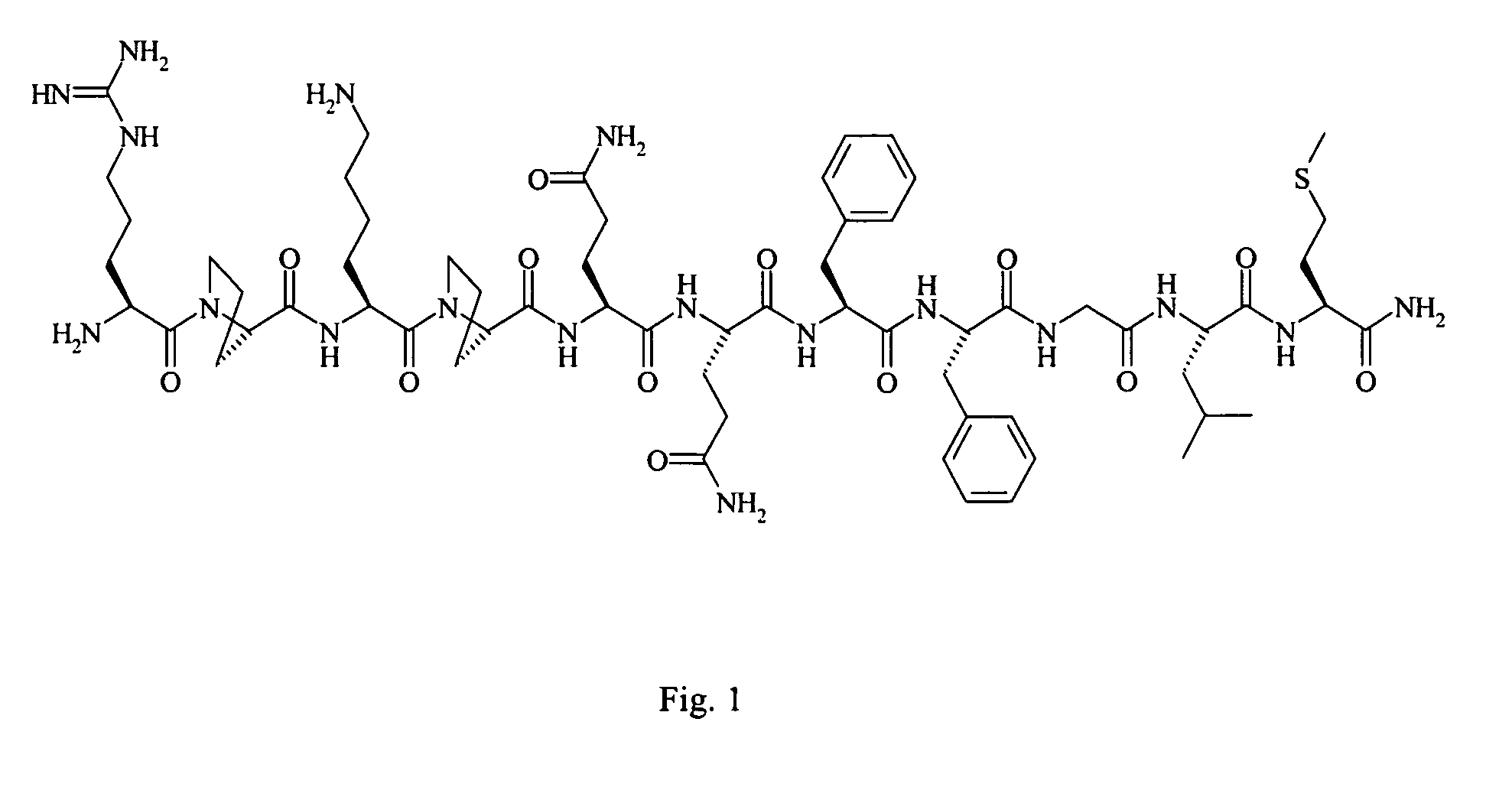Antimicrobial compounds
a technology of antimicrobial compounds and compounds, applied in the field of antimicrobial compounds, can solve the problems that many previously useful antibiotics are no longer effective against infectious organisms isolated from human and animal subjects
- Summary
- Abstract
- Description
- Claims
- Application Information
AI Technical Summary
Benefits of technology
Problems solved by technology
Method used
Image
Examples
example 1
Structure of SP and Derivatives Thereof
[0046]Peptides were synthesized by respective Boc- or Fmoc-chemistry in solid phase by methods known in the art, e.g., Misicka, et al., Biochemical & Biophysical Research Communications 1991:180(3):1290-7. Crude peptides were purified by gel filtration on Sephadex LH-20 (in methanol), followed by preparative HPLC. All peptides were confirmed to have correct amino acid analyses and molecular weights by FAB-MS. For microbiological study, peptides in acetate form were used. The sequences of the peptides are: SP, Arg-Pro-Lys-Pro-Gln-Gln-Phe-Phe-Gly-Leu-MetNH2 (FIG. 1, SEQ ID NO:1); SP antagonist, Arg-D-Pro-Lys-Pro-Gln-Gln-D-Trp-Phe-D-Trp-Leu-MetNH2 (SEQ ID NO:2); bradykinin, Arg-Pro-Pro-Gly-Phe-Ser-Pro-Phe-Arg (SEQ ID NO:3); neurotensin, Glu-Leu-Tyr-Glu-Asn-Lys-Pro-Arg-Arg-Pro-Tyr-Ile-Leu (SEQ ID NO:4) or Xaa-Leu-Tyr-Glu-Asn-Lys-Pro-Arg-Arg-Pro-Tyr-Ile-Leu (SEQ ID NO:14; where Xaa is Pyr or Tyr); and indolicidin, Ile-Leu-Pro-Trp-Lys-Trp-Pro-Trp-Trp...
example 2
Antimicrobial Activity of SP and Derivatives Using Bacterial Test Species
[0052]Antimicrobial activity, specifically antibacterial activity, was assayed using cells of each of Staphylococcus aureus NCTC 4163, Escherichia coli NCTC 8196, Pseudomonas aeruginosa NCTC 6749, Proteus vulgaris NCTC 4635, and Enterococcus faecalis ATCC 19212. To determine the minimum inhibitory concentration (MIC), the microdilution broth method, well-known to one of ordinary skill in the art of microbiology, was used. Cells of each bacterial strain were collected in the logarithmic phase of growth, and resuspended in nutrient broth. The concentration of colony-forming units (CFU) per milliliter was quantified by measuring absorption of light at 600 nm (A600).
[0053]Peptide samples were dissolved in nutrient broth (pH 7.0) and diluted serially. The sample solution (100 μl) was mixed with the diluted bacterial suspension (100 μl). Mixtures containing 105 bacterial CFU, and from 1% to 0.003% of test peptides, w...
example 3
Antifungal Activity of SP and SP Antagonist
[0059]Antifungal activity was assayed using Candida albicans NCTC 10231 as a target fungus. Candida cells in the logarithmic phase of growth were suspended in dextrose broth medium at a density of 105 CFU / ml. A mixture of the sample solution (100 μl) and the fungal suspension (100 μl) was incubated for 24 h at 37° C. Antifungal activity was assessed using turbidity measurement as described above (Table 2).
[0060]SP was found to have antifungal properties against C. albicans. Further, the SP antagonist was found to have approximately 10 times higher potency against C. albicans than either SP or bradykinin.
PUM
| Property | Measurement | Unit |
|---|---|---|
| molecular weight | aaaaa | aaaaa |
| resistance | aaaaa | aaaaa |
| hydrophobic | aaaaa | aaaaa |
Abstract
Description
Claims
Application Information
 Login to View More
Login to View More - R&D
- Intellectual Property
- Life Sciences
- Materials
- Tech Scout
- Unparalleled Data Quality
- Higher Quality Content
- 60% Fewer Hallucinations
Browse by: Latest US Patents, China's latest patents, Technical Efficacy Thesaurus, Application Domain, Technology Topic, Popular Technical Reports.
© 2025 PatSnap. All rights reserved.Legal|Privacy policy|Modern Slavery Act Transparency Statement|Sitemap|About US| Contact US: help@patsnap.com

